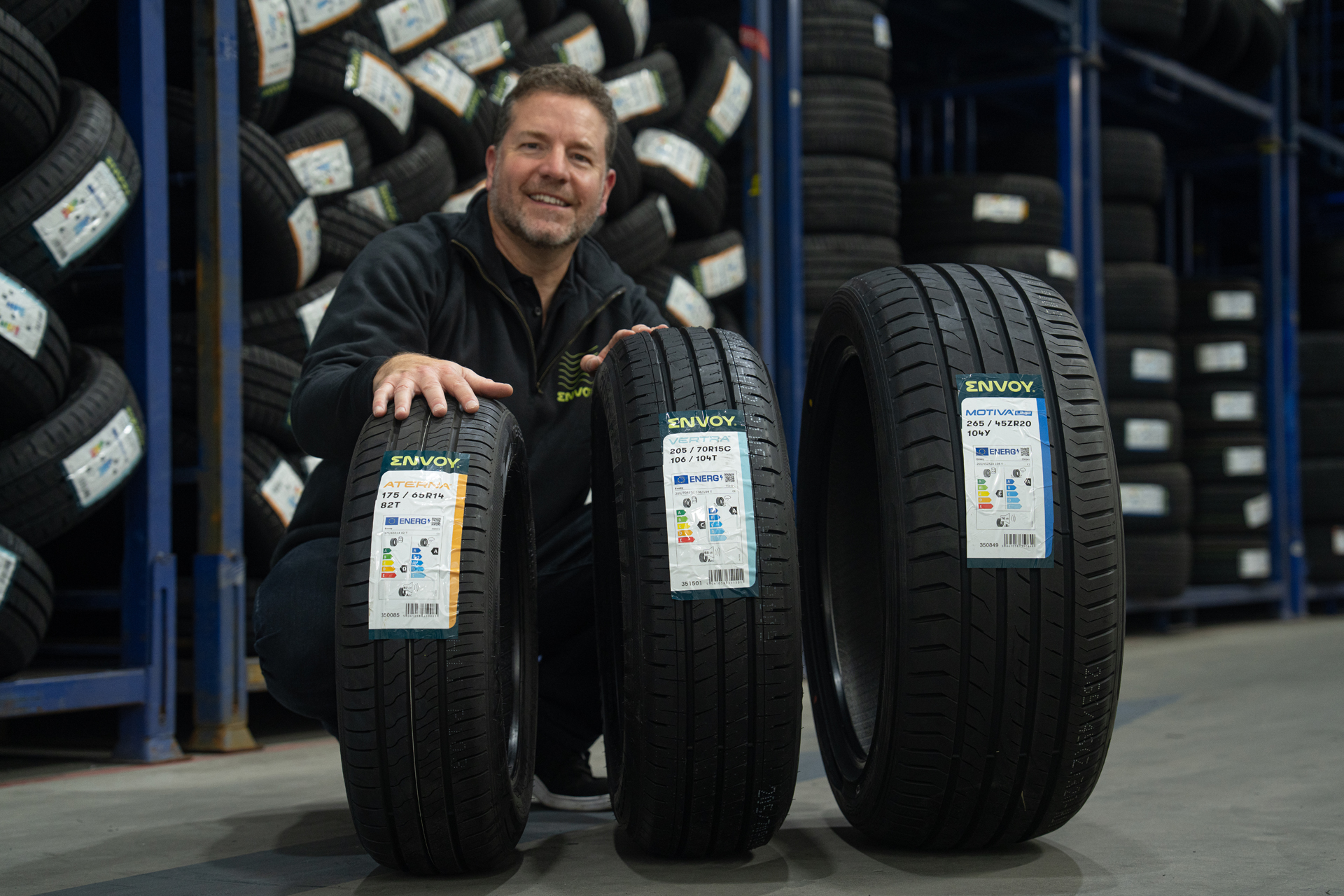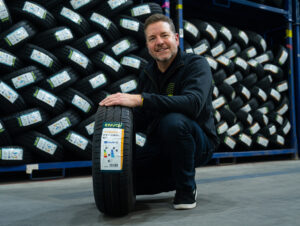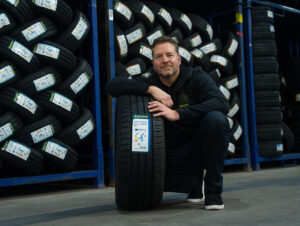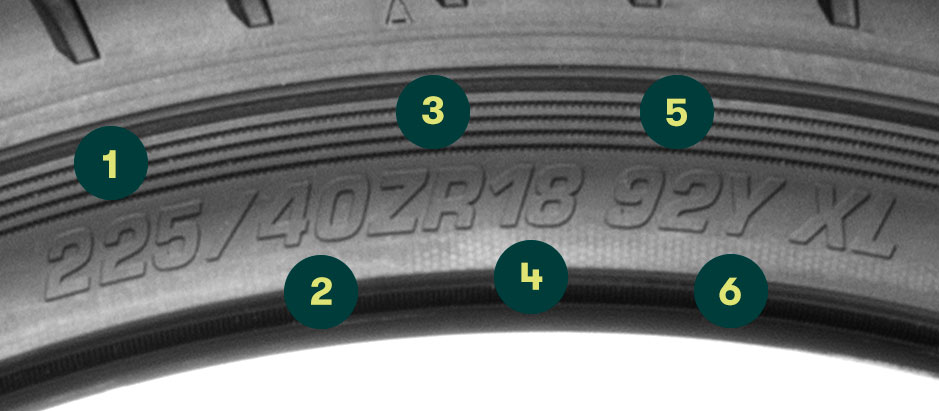What do those letters and numbers on your tyres mean? Paul Cowland’s guide to reading your rubber
Monday 27th October 2025
Picture the scene: you’re kneeling in a petrol station forecourt, squinting at the sidewall of your car’s tyre, trying to decipher what looks like the cryptic scribblings of an ancient Egyptian mechanic. It’s not just a random string of letters and numbers, mind you, it’s a code packed with vital information about your car’s rubber. But fear not, because we’re going to crack this code wide open in true Envoy fashion. And of course, if your tyre already says “Envoy” on its sidewall, you’re already off to a flying start!
Let’s start with the basics. You’ve probably noticed something like “225/45 R17 91W” embossed on the side of your tyre, along with a smattering of other numbers, letters, and of course, the aforementioned brand name. I’ll forgive you, just this once, if it doesn’t say Envoy…
Those digits aren’t just there to look pretty, or confuse you when you’re trying to replace a puncture in the rain. No, this alphanumeric soup tells you everything you need to know about your tyre’s size, performance, and purpose. So, let’s break it down, piece by piece, as I give you some industry-level knowledge for next time you want to go tyre shopping, or indeed, just want to impress your mates down the pub.
Tyre width
First up, the number at the start, the “225” in our example. This is the tyre’s width, measured in millimetres. A 225mm-wide tyre is a reasonably chunky chap, suited to a sporty saloon or a hot hatch. If that’s you, run, don’t walk, to the Motiva UHP page…
Narrower tyres, like 185mm, are more likely found on noble carriages like the Fiat Panda or Ford Fiesta, and that’s very much where Envoy’s Aterna shines. The wider the tyre, the more grip it can theoretically offer, but also the more fuel it will take to run at the same time. The trick is usually to fit what the manufacturer suggested in the first place, which you can check in your vehicle handbook.

Tyre height
Next, the second number we see in the sequence, our “45”. This is the aspect ratio – in other words, the height of the tyre’s sidewall, which is expressed as a percentage of its width. So in this case, the profile height is 45% of the tyre’s total width. A lower number, like 35, means a shorter sidewall, giving you a stiffer ride and sharper handling but also a more focussed ride quality. Perfect for sports and performance machines.
Higher numbers, like 60, are for softer, comfier rides. Think SUVs or 4x4s which are perfect for our Tordera range, or hard working vans that will lead a life of even harder knocks on our Vertra rubber.
Tyre rim
Then comes the letter “R”. This one’s easy: it stands for “radial,” which is the construction type of pretty much every tyre made since the 1970s. Radial tyres have cords running at 90 degrees to the direction of travel, which makes them strong, durable, and capable of handling the sort of speeds that would make your great-aunt Mildred clutch her pearls on the M1.
If you see anything other than an “R” here, you’re probably driving a museum piece or a tractor. Either way, congratulations on your commitment to history and/or agriculture.
Following that, we’ve got the number “17”. This is the diameter of the wheel rim in inches, because apparently, the tyre industry likes to mix metric and imperial measurements just to keep you on your toes. A 17-inch rim is fairly standard for a modern car, but if you’re rolling on 22s, you’ll be wanting the Motiva UHP page again. Smaller rims, like 15s, are for budget hatchbacks or cars designed to survive potholes the size of small craters. Financially, they’re much more fun to buy, too, using less materials, with a correspondingly lower price tag!

Load capacity
Now, onto the “91W” bit, which sounds like a radio station but is actually two separate pieces of info. The “91” is the load index, a number that corresponds to the maximum weight the tyre can carry. In this case, 91 means the tyre can handle 615kg per wheel, which is plenty for most cars. The higher the number, the more weight it can bear. Handy if you’re driving a van full of bricks right on your weight limit, or your entire 5 a side football team… plus gear!
Speed Rating
The “W” is the speed rating, and this is where things get properly exciting. It tells you the maximum speed the tyre is designed to handle before engineers start exchanging worried looks. A “W” rating means the tyre is good for up to 168mph (270km/h), which is frankly excessive for your Vauxhall Astra but absolutely essential if you’re piloting a Porsche 911 on the unrestricted Autobahn. Other ratings range from “S” (112mph, for family saloons) to “Y” (186mph, for proper supercars). If your tyre says “Q” (99mph), you’re probably driving a winter tyre… or a milk float.
Additional tyre markings
But wait, there’s more! Beyond the main code, you’ll find other markings that add to the tyre’s story. Look closely, and you might see “M+S” (Mud and Snow), which means the tyre is designed for grip in slippery conditions, though it’s not a full-on winter tyre unless it also has a little snowflake symbol. Then there’s the DOT (Department of Transportation) code, usually something like “DOT 4B7X 2519”. The last four digits are the tyre’s birthdate. 2519 means it was made in the 25th week of 2019. If your tyres are older than your school-age kids, it’s probably time to replace them, no matter how much tread is left, and particularly if you use your car to carry your school-age kids. Joking aside, perceived wisdom is around every 5 years for optimum performance and safety.
Reassuringly, in these post-Brexit times, you might also spot “E” or “ECE” markings, which mean the tyre meets European safety standards. Some tyres have directional arrows or the word “rotation” or “outside” to tell you which way they should spin or sit. And if you see “Run Flat” or “RFT,” congratulations, you’ve got a tyre that can limp along for a bit after a puncture, though it’ll still leave you cursing when you’re stuck on the hard shoulder. They’re very much a “get you home” measure when you run into trouble, rather than a James-Bond style, Q-division getaway upgrade.
So, there you have it. The tyre sidewall decoded and demystified. Next time you’re staring at those letters and numbers, you’ll know exactly what they mean, from the width of the rubber to the speed it can handle, and even, when you need a new one. It’s not just a tyre; it’s a story of engineering, performance, and the occasional pothole-induced heartbreak. Now, go forth and impress your local tyre fitter with your newfound tyre knowledge. Or better yet, take your car for a spin and let those tyres do what they were born to do; grip the road, make you grin, and remind you why driving is still one of life’s great pleasures. Unless you’re stuck in traffic, of course!
For more information about the Envoy range, check out the product page. You can also see a video of Paul explaining the letters and numbers displayed on the tyres here.



